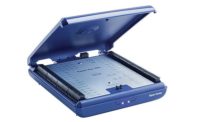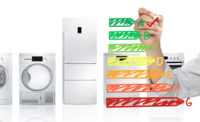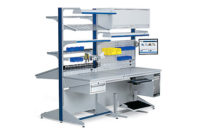Design engineers have used reed switches in low-power, battery-operated applications for four key reasons. The mechanical reed switch offers “zero” power consumption, high sensitivity, and low cost. In addition, there has not been a suitable alternative technology. These advantages are not entirely true anymore thanks to new magnetoresistive (MR) sensing IC options that can provide position sensing with virtually no power consumption, high sensitivity, and high reliability and durability, while housed in a small package.
Before the development of solid-state sensors, magnetically-activated reed switches, which have been around for decades, provided a proven and inexpensive solution for position sensing. The reed switch consists of two ferromagnetic leads that are hermetically sealed in a glass capsule or tube. When a magnet comes in range of the switch, i.e., a magnetic field is applied to the leads, the contacts close creating a switching function.
Reed switches have remained a popular choice for many designers because of their simplicity as a mechanical switch and a lack of suitable alternatives, particularly in low-power applications. Reed switches have found homes in a wide range of products. Applications include consumer electronics, metering, security, white goods/appliances, medical equipment, robotics, and automation equipment.
Though reed switches are common among these types of applications, many designers also recognize that reed switches have some key disadvantages. These include quality issues due to breakage, both in the manufacturing process and in shock and vibration applications, limited life as a mechanical switch, size issues and reliability issues due to bounce effect (when the reed switch contacts bounce apart causing the application to turn on, off and then on again).
As improvements were made to Hall-effect technology, Hall-effect sensors started to replace reed switches in some battery-powered applications such as cell phones, laptops, consumer electronics, and white goods. This was driven by designers who continue to demand higher reliability and higher performance switching.
Like a reed switch, the Hall-effect sensor actuates when a magnet comes in range of the device. One of the biggest advantages of Hall-effect sensors is that they are solid state and immune to wear, shock and vibration. Switch bounce is also not an issue as there are no moving parts in the solid state sensor. In addition, Hall-effect devices are more rugged and compact than reed switches, making them well-suited for use in many of the same applications. Pricing is also equivalent to the relatively inexpensive reed switches.
Despite these advantages and inroads into some low-power applications, Hall-effect sensors today cannot replace reed switches in many applications because they do not meet the high sensitivity and extremely low-power requirements needed for many battery-operated devices.
For design engineers who are looking for an alternative to reed switches to reduce size, increase quality and durability, and maximize battery life, there are new MR technologies that offer power requirements in the sub-500 nanoamp (nA) range, while offering high sensitivity at a price point that is equivalent to reed switches.
Like Hall sensors, MR sensors are solid state magnetic sensors. The key difference is that they sense in the parallel plane of the sensing element vs. the perpendicular plane for Hall-effect, and they are typically much more sensitive.
This enables the MR sensors to be used in virtually any battery-operated application.
Here are four reasons—high sensitivity, low power, small size and inherent solid-state advantages—why designers of battery-operated products should consider making the transition from reed switches to MR sensors.
1. High Sensitivity is Required for Battery-Operated Equipment
High-sensitivity magnetic sensors allow manufacturers to use smaller or lower strength magnets, which reduces cost and enables smaller designs. This has become a bigger issue over the past several years as the pricing for rare earth magnets has increased significantly. Another benefit is that it allows for a larger air gap, which provides greater design flexibility by allowing the designer to place the sensor further away from the magnet and still maintain reliability.
Reed switches offer a high sensitivity range required for low-power, battery-operated applications. The magnetic sensitivity of reed switches is measured in ampere-turns (AT), while the sensitivity of MR sensors is measured in gauss. Using a 10 AT high-sensitivity reed switch as an example, this would be equivalent to a 10 to 20 gauss magnetic sensor. The high-sensitivity range for a Hall-effect sensor, for example, is about 30 gauss typical. This means a reed switch can sense a magnetic target at two times the distance or more of a high-sensitivity Hall-effect sensor, offering higher design flexibility for those applications that require a large air gap. But, reed switches also have a number of drawbacks, which will be discussed later.
Today, reed switches are not the only switch option with high sensitivity, as sensor manufacturers continue to advance MR technologies. With new products available today, the sensitivity of these sensors is equivalent to or higher than their high sensitivity reed switch counterparts.
2. Battery-Operated Equipment has Extremely Low-Power Requirements
One of the key benefits of a reed switch in battery-operated applications is that it does not require power to make it work, making the technology ideal for battery-operated equipment.
Up until the early 2000s, magnetic sensors all used power in the milliamp range so they could not be considered for any low-power applications. Around this time, electrical engineers started to work with CMOS technology, allowing magnetic sensor designers to add an internal clock into the devices in order to give it a sleep/awake mode to lower the power requirements of the sensor.
As the technology improved, the power consumption of magnetic sensors dropped to single-digit microamps. Today, for example, Hall-effect sensors have power requirements of 3-8 µA, depending on the manufacturer and parts. New MR sensor technologies can consume only 360 nA, enabling the sensor to be used as a replacement for reed switches in most battery-operated equipment, requiring 10 times less power than competitive sensors.
These sensors can be used in a variety of battery-operated applications including portable power tools, water and gas meters, industrial smoke detectors, exercise equipment, security systems, handheld computers, and scanners. They can also be used in white goods such as dishwashers, microwaves, washing machines, refrigerators and coffee machines, and medical equipment such as hospital beds, medication dispensing cabinets, infusion pumps, and consumer electronics such as notebook computers, tablets, and cordless speakers.
3. Reed Switches Have Several Inherent Drawbacks
Reed switches have several inherent disadvantages, including susceptibility to breakage issues during installation, and in shock or vibration applications, lower durability, a limited life due to the mechanical nature of the switch, as well as issues due to “contact bounce.”
Reliability and durability are challenges for reed switch users. When leads on the reed switches are soldered into the circuit, they bend and can easily crack the glass enclosure of the switch, rendering the switch unusable. In fact, there is quite a bit of breakage on these types of units, and quite often, reed switch manufacturers will provide very specific installation instructions in order to limit this breakage. One solution is to enclose the reed switch in a plastic casing, but this adds to the cost and size of the switch.
Reed switches are also impacted by shock and vibration, which can separate the contacts of the switch, making the part unreliable. Mechanical reed switches will wear out over time. As a result, cell phone designers, for example, were the first to transition to Hall-effect sensors. Magnetic sensors are solid-state devices with no moving parts so they will not wear out over time. They are also housed in plastic molded packages versus a glass tube or enclosure for reed switches.
“Contact bounce,” which can result in several make-break cycles (close/open/close), also causes issues for designers using reed switches. To fix the problem, engineers need to implement a “de-bounce” function in either hardware or software, adding additional risk to the system and time to a designer’s development cycle.
MR sensors eliminate each of these issues. As a solid state sensor in a molded plastic package, these units have no moving parts and are virtually immune to breakage and wear and tear.
4. Size is an Issue
The relatively large size of reed switches makes them a bottleneck in product miniaturization. When comparing reed switches and the new AMR sensors with about the same sensitivity range, reed switches are significantly larger than the SOT-23 package, measuring 2.9 mm x 2.8 mm x 1.45 mm. The relatively small size of the AMR sensor will allow for designs to continue the trend of miniaturization, lowering cost and adding to opportunities for new applications.
As sensor manufacturers continue to advance MR sensor technologies, designers will have one more sensor technology in their arsenal for battery-operated equipment. These AMR solid-state devices are inherently more reliable and durable thanks to no moving parts; they are smaller than reed switches and are available in the same sensitivity range. This allows designers to develop smaller, more reliable, and higher quality appliances and devices with virtually no power required by the sensor components.




